Ultrasensitive Materials for Electrochemical Biosensor Labels
Abstract
1. Introduction
2. Enzyme Labels Combined with Electrochemical Applications
3. Nanoparticles as Labels for Electrochemical Applications
4. Quantum Dots (QDs) as Labels for Electrochemical Applications
5. Redox-Active Molecules as Labels for Electrochemical Applications
6. Low Dimensional Carbon Materials as Ultrasensitive Labels
7. Summary and Outlook
Author Contributions
Funding
Institutional Review Board Statement
Informed Consent Statement
Acknowledgments
Conflicts of Interest
Abbreviations
| AFP | Alpha-fetoprotein |
| Ag NPs | Silver nanoparticles |
| ALP | Alkaline phosphatase |
| anti-tTG | Anti-tissue transglutaminase immunoglobulin A antibodies |
| ApoE | Apolipoprotein E |
| ATP | Adenosine triphosphate |
| Au NPs | Gold nanoparticles |
| BSA | Bovine serum albumin |
| CA125 | Carcinoma antigen 125 |
| CdS QDs | Cadmium sulfide quantum dots |
| CdSe@ZnS QDs | Cadmium selenide@Zinc sulfide quantum dots |
| CdTe QDs | Cadmium telluride quantum dots |
| CEA | Carcinoembryonic antigen |
| cTnI | Cardiac troponin I |
| cTnT | Cardiac troponin T |
| Cu NPs | Copper nanoparticles |
| CV | Cyclic voltammetry |
| CVs | Cyclic voltammograms |
| DNA | Deoxyribonucleic acid |
| DPV | Differential pulse voltammetry |
| DT-D | DT-Diaphorase |
| DμFD | Disposable microfluidic device |
| E. coli | Escherichia coli |
| ECL | Electrochemiluminescence |
| EIS | Electrochemical impedance spectroscopy |
| Fe3O4 NPs | Ferromagnetic nanoparticles |
| G6PDH | Glucose-6-phosphate dehydrogenase |
| GCE | Glassy carbon electrode |
| GIgG | Goat immunoglobulin G |
| GN | Graphene |
| GO NPs | Graphene oxide nanoparticles |
| GO | Graphene oxide |
| GOx | Glucose oxidase |
| GPDH | Glycerol-3-phosphate dehydrogenase |
| GSH | Glutathione |
| HgSe NPs | Mercury selenide nanoparticles |
| HIgG | Human Immunoglobulin G |
| HRP | Horseradish peroxidase |
| IgG | Immunoglobulin G |
| IL-6 | Interleukin-6 |
| Ir NPs | Iridium nanoparticles |
| IrO2 NPs | Iridium oxide nanoparticles |
| ITO | Indium tin oxide |
| LOx | Lactate oxidase |
| LSV | Linear sweep voltammetry |
| MBs | Magnetic beads |
| miR-141 | MicroRNA 141 |
| miR-21 | MicroRNA 21 |
| MoS2 NPs | Molybdenum disulfide nanoparticles |
| MSNs | Mesoporous silica nanoparticles |
| MSO | Mercury-specific oligonucleotide |
| MWCNT | Multi-walled carbon nanotubes |
| NPs | Nanoparticles |
| ORR | Oxygen reduction reaction |
| PAP | p-aminophenol |
| PAPG | p-aminophenyl galactopyranoside |
| PBS | Sodium phosphate buffer |
| PCB | Polychlorinated biphenyls |
| Pd NPs | Palladium nanoparticles |
| PDBE | Polybrominated diphenyl ethers |
| PEC | Photoelectrochemical |
| POC | Point-of-care |
| PSA | Prostate specific antigen |
| Pt NPs | Platinum nanoparticles |
| PTH | Parathyroid hormone |
| QDs | Quantum Dots |
| Rct | Charge transfer resistance |
| RIgG | Rabbit immunoglobulin G |
| S. typhi | Salmonella typhimurium |
| SARS | Severe acute respiratory syndrome |
| SEM | Scanning electron microscope |
| SPEs | Screen-printed electrodes |
| ssDNA | Single stranded DNA |
| SWASV | Square wave anodic stripping voltammetry |
| SWCNT | Single walled carbon nanotubes |
| SWSV | Square wave stripping voltammetry |
| SWV | Square wave voltammetry |
| TCID | Tissue culture infective dose |
| t-DNA | Transfer DNA |
| TEM | Transmission electron microscopy |
| TGA | Thioglycolic acid |
| TiO2 NPs | Titanium dioxide nanoparticles |
| TMB | 3,3′,5,5′-Tetramethylbenzidine |
| XPS | X-ray photoelectron spectroscopy |
| ZnS NPs | Zinc sulfide nanoparticles |
| α-SYN | α-Synuclein |
| β-gal | β-galactosidase |
References
- Carr, O.; Raymundo-Pereira, P.A.; Shimizu, F.M.; Sorroche, B.P.; Melendez, M.E.; de Oliveira, P.R.; Oliveira, O.N., Jr. Genosensor made with a self-assembled monolayer matrix to detect MGMT gene methylation in head and neck cancer cell lines. Talanta 2020, 210, 120609. [Google Scholar] [CrossRef] [PubMed]
- Raymundo-Pereira, P.A.; Shimizu, F.M.; Coelho, D.; Piazzeta, M.H.O.; Gobbi, A.L.; Machado, S.A.S. A Nanostructured Bifunctional platform for Sensing of Glucose Biomarker in Artificial Saliva: Synergy in hybrid Pt/Au surfaces. Biosens. Bioelectron. 2016, 86, 369–376. [Google Scholar] [CrossRef] [PubMed]
- Dos Santos Pereira, T.; Mauruto de Oliveira, G.C.; Santos, F.A.; Raymundo-Pereira, P.A.; Oliveira, O.N.; Janegitz, B.C. Use of zein microspheres to anchor carbon black and hemoglobin in electrochemical biosensors to detect hydrogen peroxide in cosmetic products, food and biological fluids. Talanta 2019, 194, 737–744. [Google Scholar] [CrossRef]
- Chen, Z.; Zhang, X.; Yang, R.; Zhu, Z.; Chen, Y.; Tan, W. Single-walled carbon nanotubes as optical materials for biosensing. Nanoscale 2011, 3, 1949–1956. [Google Scholar] [CrossRef] [PubMed]
- Mohammadniaei, M.; Go, A.; Chavan, S.G.; Koyappayil, A.; Kim, S.E.; Yoo, H.J.; Min, J.; Lee, M.H. Relay-race RNA/barcode gold nanoflower hybrid for wide and sensitive detection of microRNA in total patient serum. Biosens. Bioelectron. 2019, 141, 111468. [Google Scholar] [CrossRef]
- Sahoo, H. Fluorescent labeling techniques in biomolecules: A flashback. RSC Adv. 2012, 2, 7017–7029. [Google Scholar] [CrossRef]
- Wang, C.; Chen, Y.; Wang, T.; Ma, Z.; Su, Z. Monodispersed Gold Nanorod-Embedded Silica Particles as Novel Raman Labels for Biosensing. Adv. Funct. Mater. 2008, 18, 355–361. [Google Scholar] [CrossRef]
- Takamura, T.; Morimoto, Y.; Sandhu, A. Planar Microfluidic System Based on Electrophoresis for Detection of 130-nm Magnetic Labels for Biosensing. Jpn. J. Appl. Phys. 2011, 50, 04DL10. [Google Scholar] [CrossRef]
- Zhou, Y.; Chen, S.; Luo, X.; Chai, Y.; Yuan, R. Ternary Electrochemiluminescence Nanostructure of Au Nanoclusters as a Highly Efficient Signal Label for Ultrasensitive Detection of Cancer Biomarkers. Anal. Chem. 2018, 90, 10024–10030. [Google Scholar] [CrossRef]
- Zoski, C.G. Nanoscale scanning electrochemical microscopy: Emerging advances in applications and theory. Curr. Opin. Electrochem. 2017, 1, 46–52. [Google Scholar] [CrossRef]
- Sadik, O.A.; Aluoch, A.O.; Zhou, A. Status of biomolecular recognition using electrochemical techniques. Biosens. Bioelectron. 2009, 24, 2749–2765. [Google Scholar] [CrossRef] [PubMed]
- Barry, S.; O’Riordan, A. Electrochemical nanosensors: Advances and applications. Rep. Electrochem. 2016, 6, 1. [Google Scholar]
- Liu, Z.; Qi, W.; Xu, G. Recent advances in electrochemiluminescence. Chem. Soc. Rev. 2015, 44, 3117–3142. [Google Scholar] [CrossRef] [PubMed]
- Batchelor-McAuley, C.; Kätelhön, E.; Barnes, E.O.; Compton, R.G.; Laborda, E.; Molina, A. Recent advances in voltammetry. ChemistryOpen 2015, 4, 224. [Google Scholar] [CrossRef]
- Mirceski, V.; Gulaboski, R. Recent achievements in square-wave voltammetry (a review). Maced. J. Chem. Chem. Eng. 2014, 33, 1–12. [Google Scholar]
- Lawrence, N.S.; Beckett, E.L.; Davis, J.; Compton, R.G. Advances in the voltammetric analysis of small biologically relevant compounds. Anal. Biochem. 2002, 303, 1–16. [Google Scholar] [CrossRef]
- Trojanowicz, M.; Szewczynska, M.; Wcislo, M. Electroanalytical flow measurements—Recent advances. Electroanal. Int. J. Devoted Fundam. Pract. Asp. Electroanal. 2003, 15, 347–365. [Google Scholar] [CrossRef]
- Grieshaber, D.; MacKenzie, R.; Vörös, J.; Reimhult, E. Electrochemical biosensors-sensor principles and architectures. Sensors 2008, 8, 1400–1458. [Google Scholar] [CrossRef]
- O’sullivan, M.; Bridges, J.; Marks, V. Enzyme immunoassay: A review. Ann. Clin. Biochem. 1979, 16, 221–239. [Google Scholar] [CrossRef]
- Savage, M.; Mattson, G.; Desai, S.; Nielander, G.; Morgensen, S.; Conklin, E. Avidin-Biotin Chemistry: A Handbook, 2nd ed.; Pierce Chemical Company: Rockford, IL, USA, 1994. [Google Scholar]
- Zhao, W.-W.; Chen, R.; Dai, P.-P.; Li, X.-L.; Xu, J.-J.; Chen, H.-Y. A General Strategy for Photoelectrochemical Immunoassay Using an Enzyme Label Combined with a CdS Quantum Dot/TiO2 Nanoparticle Composite Electrode. Anal. Chem. 2014, 86, 11513–11516. [Google Scholar] [CrossRef]
- Kang, C.; Kang, J.; Lee, N.-S.; Yoon, Y.H.; Yang, H. DT-Diaphorase as a Bifunctional Enzyme Label That Allows Rapid Enzymatic Amplification and Electrochemical Redox Cycling. Anal. Chem. 2017, 89, 7974–7980. [Google Scholar] [CrossRef] [PubMed]
- De la Escosura-Muñiz, A.; Parolo, C.; Maran, F.; Mekoçi, A. Size-dependent direct electrochemical detection of gold nanoparticles: Application in magnetoimmunoassays. Nanoscale 2011, 3, 3350–3356. [Google Scholar] [CrossRef] [PubMed]
- Miao, P.; Han, K.; Sun, H.; Yin, J.; Zhao, J.; Wang, B.; Tang, Y. Melamine Functionalized Silver Nanoparticles as the Probe for Electrochemical Sensing of Clenbuterol. ACS Appl. Mater. Interfaces 2014, 6, 8667–8672. [Google Scholar] [CrossRef] [PubMed]
- Russo, L.; Leva Bueno, J.; Bergua, J.F.; Costantini, M.; Giannetto, M.; Puntes, V.; Merkoçi, A. Low-Cost Strategy for the Development of a Rapid Electrochemical Assay for Bacteria Detection Based on Au-Ag Nanoshells. ACS Omega 2018, 3, 18849–18856. [Google Scholar] [CrossRef]
- Quesada-González, D.; Baiocco, A.; Martos, A.A.; de la Escosura-Muñiz, A.; Palleschi, G.; Merkoçi, A. Iridium oxide (IV) nanoparticle-based electrocatalytic detection of PBDE. Biosens. Bioelectron. 2019, 127, 150–154. [Google Scholar] [CrossRef]
- Li, W.; Fan, G.-C.; Gao, F.; Cui, Y.; Wang, W.; Luo, X. High-activity Fe3O4 nanozyme as signal amplifier: A simple, low-cost but efficient strategy for ultrasensitive photoelectrochemical immunoassay. Biosens. Bioelectron. 2019, 127, 64–71. [Google Scholar] [CrossRef]
- Xiong, W.; Wu, S.F.; Liao, F.S.; Hong, N.; Fan, H.; Wei, G.B. A ZnS-Nanoparticle-Label-Based Electrochemical Codeine Sensor. In Applied Mechanics and Materials; Trans Tech Publications Ltd.: Bach, Switzerland, 2017; pp. 173–177. [Google Scholar]
- Balasubramanian, S.K.; Yang, L.; Yung, L.-Y.L.; Ong, C.-N.; Ong, W.-Y.; Liya, E.Y. Characterization, purification, and stability of gold nanoparticles. Biomaterials 2010, 31, 9023–9030. [Google Scholar] [CrossRef]
- Spampinato, V.; Parracino, M.A.; la Spina, R.; Rossi, F.; Ceccone, G. Surface Analysis of Gold Nanoparticles Functionalized with Thiol-Modified Glucose SAMs for Biosensor Applications. Front. Chem. 2016, 4. [Google Scholar] [CrossRef]
- Reimers, J.R.; Ford, M.J.; Halder, A.; Ulstrup, J.; Hush, N.S. Gold surfaces and nanoparticles are protected by Au(0)-thiyl species and are destroyed when Au(I)-thiolates form. Proc. Natl. Acad. Sci. USA 2016, 113, E1424–E1433. [Google Scholar] [CrossRef]
- Daniel, M.-C.; Astruc, D. Gold nanoparticles: Assembly, supramolecular chemistry, quantum-size-related properties, and applications toward biology, catalysis, and nanotechnology. Chem. Rev. 2004, 104, 293–346. [Google Scholar] [CrossRef]
- De Oliveira, T.R.; Martucci, D.H.; Faria, R.C. Simple disposable microfluidic device for Salmonella typhimurium detection by magneto-immunoassay. Sens. Actuators B Chem. 2018, 255, 684–691. [Google Scholar] [CrossRef]
- Liao, K.-T.; Huang, H.-J. Femtomolar immunoassay based on coupling gold nanoparticle enlargement with square wave stripping voltammetry. Anal. Chim. Acta 2005, 538, 159–164. [Google Scholar] [CrossRef]
- Mao, X.; Jiang, J.; Chen, J.; Huang, Y.; Shen, G.; Yu, R. Cyclic accumulation of nanoparticles: A new strategy for electrochemical immunoassay based on the reversible reaction between dethiobiotin and avidin. Anal. Chim. Acta 2006, 557, 159–163. [Google Scholar] [CrossRef]
- Leng, C.; Lai, G.; Yan, F.; Ju, H. Gold nanoparticle as an electrochemical label for inherently crosstalk-free multiplexed immunoassay on a disposable chip. Anal. Chim. Acta 2010, 666, 97–101. [Google Scholar] [CrossRef] [PubMed]
- Tschulik, K.; Batchelor-McAuley, C.; Toh, H.-S.; Stuart, E.J.E.; Compton, R.G. Electrochemical studies of silver nanoparticles: A guide for experimentalists and a perspective. Phys. Chem. Chem. Phys. 2014, 16, 616–623. [Google Scholar] [CrossRef]
- Ting, B.P.; Zhang, J.; Khan, M.; Yang, Y.Y.; Ying, J.Y. The solid-state Ag/AgCl process as a highly sensitive detection mechanism for an electrochemical immunosensor. Chem. Commun. 2009, 6231–6233. [Google Scholar] [CrossRef]
- Niemeyer, C.M. Nanoparticles, Proteins, and Nucleic Acids: Biotechnology Meets Materials Science. Angew. Chem. Int. Ed. 2001, 40, 4128–4158. [Google Scholar] [CrossRef]
- Xiong, H.-M.; Wang, Z.-D.; Xia, Y.-Y. Polymerization Initiated by Inherent Free Radicals on Nanoparticle Surfaces: A Simple Method of Obtaining Ultrastable (ZnO)Polymer Core-Shell Nanoparticles with Strong Blue Fluorescence. Adv. Mater. 2006, 18, 748–751. [Google Scholar] [CrossRef]
- Jun, Y.-W.; Lee, J.-H.; Cheon, J. Chemical Design of Nanoparticle Probes for High-Performance Magnetic Resonance Imaging. Angew. Chem. Int. Ed. 2008, 47, 5122–5135. [Google Scholar] [CrossRef]
- Leschkies, K.S.; Divakar, R.; Basu, J.; Enache-Pommer, E.; Boercker, J.E.; Carter, C.B.; Aydil, E.S. Photosensitization of ZnO Nanowires with CdSe Quantum Dots for Photovoltaic Devices. Nano Lett. 2007, 7, 1793–1798. [Google Scholar] [CrossRef]
- Xu, F.; Zhang, P.; Navrotsky, A.; Yuan, Z.Y.; Ren, T.Z.; Halasa, M.; Su, B.L. Hierarchically Assembled Porous ZnO Nanoparticles: Synthesis, Surface Energy, and Photocatalytic Activity. Chem. Mater. 2007, 19, 5680–5686. [Google Scholar] [CrossRef]
- Bruchez, M.; Moronne, M.; Gin, P.; Weiss, S.; Alivisatos, A.P. Semiconductor Nanocrystals as Fluorescent Biological Labels. Science 1998, 281, 2013–2016. [Google Scholar] [CrossRef]
- Chan, W.C.W.; Nie, S. Quantum Dot Bioconjugates for Ultrasensitive Nonisotopic Detection. Science 1998, 281, 2016–2018. [Google Scholar] [CrossRef]
- Cui, R.; Pan, H.-C.; Zhu, J.-J.; Chen, H.-Y. Versatile Immunosensor Using CdTe Quantum Dots as Electrochemical and Fluorescent Labels. Anal. Chem. 2007, 79, 8494–8501. [Google Scholar] [CrossRef] [PubMed]
- Hu, X.; Wang, R.; Ding, Y.; Zhang, X.; Jin, W. Electrochemiluminescence of CdTe quantum dots as labels at nanoporous gold leaf electrodes for ultrasensitive DNA analysis. Talanta 2010, 80, 1737–1743. [Google Scholar] [CrossRef] [PubMed]
- Medina-Sánchez, M.; Miserere, S.; Morales-Narváez, E.; Merkoçi, A. On-chip magneto-immunoassay for Alzheimer’s biomarker electrochemical detection by using quantum dots as labels. Biosens. Bioelectron. 2014, 54, 279–284. [Google Scholar] [CrossRef]
- Li, T.; Yang, M.H. Electrochemical sensor utilizing ferrocene loaded porous polyelectrolyte nanoparticles as label for the detection of protein biomarker IL-6. Sens. Actuators B Chem. 2011, 158, 361–365. [Google Scholar] [CrossRef]
- Ning, S.; Zhou, M.; Liu, C.; Waterhouse, G.I.N.; Dong, J.; Ai, S. Ultrasensitive electrochemical immunosensor for avian leukosis virus detection based on a β-cyclodextrin-nanogold-ferrocene host-guest label for signal amplification. Anal. Chim. Acta 2019, 1062, 87–93. [Google Scholar] [CrossRef]
- Choi, W.; Lee, J. Graphene: Synthesis and Applications; CRC Press: Boca Raton, FL, USA, 2011. [Google Scholar]
- Neto, A.H.C.; Guinea, F.; Peres, N.M.R.; Novoselov, K.S.; Geim, A.K. The electronic properties of graphene. RvMP 2009, 81, 109–162. [Google Scholar]
- Pop, E.; Varshney, V.; Roy, A.K. Thermal properties of graphene: Fundamentals and applications. MRS Bull. 2012, 37, 1273–1281. [Google Scholar] [CrossRef]
- Papageorgiou, D.G.; Kinloch, I.A.; Young, R.J. Mechanical properties of graphene and graphene-based nanocomposites. Prog. Mater. Sci. 2017, 90, 75–127. [Google Scholar] [CrossRef]
- Falkovsky, L. Optical properties of graphene. J. Phys. Conf. Ser. 2008, 129, 012004. [Google Scholar] [CrossRef]
- Ambrosi, A.; Chua, C.K.; Latiff, N.M.; Loo, A.H.; Wong CH, A.; Eng AY, S.; Pumera, M. Graphene and its electrochemistry—An update. Chem. Soc. Rev. 2016, 45, 2458–2493. [Google Scholar] [CrossRef] [PubMed]
- Ambrosi, A.; Chua, C.K.; Bonanni, A.; Pumera, M. Electrochemistry of graphene and related materials. Chem. Rev. 2014, 114, 7150–7188. [Google Scholar] [CrossRef]
- Al Hassan, M.; Sen, A.; Zaman, T.; Mostari, M. Emergence of graphene as a promising anode material for rechargeable batteries: A review. Mater. Today Chem. 2019, 11, 225–243. [Google Scholar] [CrossRef]
- Macedo, L.J.; Iost, R.M.; Hassan, A.; Balasubramanian, K.; Crespilho, F.N. Bioelectronics and interfaces using monolayer graphene. ChemElectroChem 2019, 6, 31–59. [Google Scholar] [CrossRef]
- Szunerits, S.; Boukherroub, R. Graphene-based nanomaterials in innovative electrochemistry. Curr. Opin. Electrochem. 2018, 10, 24–30. [Google Scholar] [CrossRef]
- Peterlevitz, A.; May, P.; Harniman, R.; Jones, J.; Ceragioli, H.; Zanin, H. Fast electron transfer kinetics on novel interconnected nanospheres of graphene layers electrodes. Thin Solid Film. 2016, 616, 698–702. [Google Scholar] [CrossRef]
- Bonanni, A. Advances on the Use of Graphene as a Label for Electrochemical Biosensors. ChemElectroChem 2020, 7, 4177–4185. [Google Scholar] [CrossRef]
- Bonanni, A.; Chua, C.K.; Zhao, G.; Sofer, Z.; Pumera, M. Inherently Electroactive Graphene Oxide Nanoplatelets As Labels for Single Nucleotide Polymorphism Detection. ACS Nano 2012, 6, 8546–8551. [Google Scholar] [CrossRef]
- Wang, L.; Xu, M.; Han, L.; Zhou, M.; Zhu, C.; Dong, S. Graphene enhanced electron transfer at aptamer modified electrode and its application in biosensing. Anal. Chem. 2012, 84, 7301–7307. [Google Scholar] [CrossRef] [PubMed]
- Charlier, J.-C.; Blase, X.; Roche, S. Electronic and transport properties of nanotubes. Rev. Mod. Phys. 2007, 79, 677–732. [Google Scholar] [CrossRef]
- Liu, Z.; Tabakman, S.; Welsher, K.; Dai, H. Carbon nanotubes in biology and medicine: In vitro and in vivo detection, imaging and drug delivery. Nano Res. 2009, 2, 85–120. [Google Scholar] [CrossRef]
- Negri, V.; Pacheco-Torres, J.; Calle, D.; López-Larrubia, P. Carbon nanotubes in biomedicine. Top. Curr. Chem. 2020, 378, 15. [Google Scholar] [CrossRef] [PubMed]
- Abera, A.; Choi, J.-W. Quantitative lateral flow immunosensor using carbon nanotubes as label. Anal. Methods 2010, 2, 1819–1822. [Google Scholar] [CrossRef]
- An, Y.; Tang, L.; Jiang, X.; Chen, H.; Yang, M.; Jin, L.; Zhang, W. A Photoelectrochemical Immunosensor Based on Au-Doped TiO2 Nanotube Arrays for the Detection of α-Synuclein. Chem. Eur. J. 2010, 16, 14439–14446. [Google Scholar] [CrossRef]
- Zhao, W.-W.; Ma, Z.-Y.; Yan, D.-Y.; Xu, J.-J.; Chen, H.-Y. In Situ Enzymatic Ascorbic Acid Production as Electron Donor for CdS Quantum Dots Equipped TiO2 Nanotubes: A General and Efficient Approach for New Photoelectrochemical Immunoassay. Anal. Chem. 2012, 84, 10518–10521. [Google Scholar] [CrossRef] [PubMed]
- Pakchin, P.S.; Ghanbari, H.; Saber, R.; Omidi, Y. Electrochemical immunosensor based on chitosan-gold nanoparticle/carbon nanotube as a platform and lactate oxidase as a label for detection of CA125 oncomarker. Biosens. Bioelectron. 2018, 122, 68–74. [Google Scholar] [CrossRef]
- Del Carlo, M.; Mascini, M. Enzyme immunoassay with amperometric flow-injection analysis using horseradish peroxidase as a label. Application to the determination of polychlorinated biphenyls. Anal. Chim. Acta 1996, 336, 167–174. [Google Scholar] [CrossRef]
- Dutta, G.; Park, S.; Singh, A.; Seo, J.; Kim, S.; Yang, H. Low-Interference Washing-Free Electrochemical Immunosensor Using Glycerol-3-phosphate Dehydrogenase as an Enzyme Label. Anal. Chem. 2015, 87, 3574–3578. [Google Scholar] [CrossRef]
- Liao, K.-T.; Cheng, J.-T.; Li, C.-L.; Liu, R.-T.; Huang, H.-J. Ultra-sensitive detection of mutated papillary thyroid carcinoma DNA using square wave stripping voltammetry method and amplified gold nanoparticle biomarkers. Biosens. Bioelectron. 2009, 24, 1899–1904. [Google Scholar] [CrossRef] [PubMed]
- Shahdost-fard, F.; Salimi, A.; Khezrian, S. Highly selective and sensitive adenosine aptasensor based on platinum nanoparticles as catalytical label for amplified detection of biorecognition events through H2O2 reduction. Biosens. Bioelectron. 2014, 53, 355–362. [Google Scholar] [CrossRef]
- Wei, Y.; Li, Y.; Li, N.; Zhang, Y.; Yan, T.; Ma, H.; Wei, Q. Sandwich-type electrochemical immunosensor for the detection of AFP based on Pd octahedral and APTES-M-CeO2-GS as signal labels. Biosens. Bioelectron. 2016, 79, 482–487. [Google Scholar] [CrossRef] [PubMed]
- Wang, Z.; Han, P.; Mao, X.; Yin, Y.; Cao, Y. Sensitive detection of glutathione by using DNA-templated copper nanoparticles as electrochemical reporters. Sens. Actuators B Chem. 2017, 238, 325–330. [Google Scholar] [CrossRef]
- Miao, L.; Jiao, L.; Zhang, J.; Li, H. Amperometric sandwich immunoassay for the carcinoembryonic antigen using a glassy carbon electrode modified with iridium nanoparticles, polydopamine and reduced graphene oxide. Microchim. Acta 2017, 184, 169–175. [Google Scholar] [CrossRef]
- Yang, M.; Li, H.; Javadi, A.; Gong, S. Multifunctional mesoporous silica nanoparticles as labels for the preparation of ultrasensitive electrochemical immunosensors. Biomaterials 2010, 31, 3281–3286. [Google Scholar] [CrossRef]
- Bouša, D.; Mayorga-Martinez, C.C.; Mazánek, V.; Sofer, Z.; Boušová, K.; Pumera, M. MoS2 Nanoparticles as Electrocatalytic Labels in Magneto-Immunoassays. ACS Appl. Mater. Interfaces 2018, 10, 16861–16866. [Google Scholar] [CrossRef]
- Yang, M.; Javadi, A.; Gong, S. Sensitive electrochemical immunosensor for the detection of cancer biomarker using quantum dot functionalized graphene sheets as labels. Sens. Actuators B Chem. 2011, 155, 357–360. [Google Scholar] [CrossRef]
- Martín-Yerga, D.; González-García, M.B.; Costa-García, A. Electrochemical immunosensor for anti-tissue transglutaminase antibodies based on the in situ detection of quantum dots. Talanta 2014, 130, 598–602. [Google Scholar] [CrossRef]
- Kara, P.; Ozkan, D.; Kerman, K.; Meric, B.; Erdem, A.; Ozsoz, M. DNA sensing on glassy carbon electrodes by using hemin as the electrochemical hybridization label. Anal. Bioanal. Chem. 2002, 373, 710–716. [Google Scholar] [CrossRef]
- García-González, R.; Costa-García, A.; Fernández-Abedul, M.T. Methylene blue covalently attached to single stranded DNA as electroactive label for potential bioassays. Sens. Actuators B Chem. 2014, 191, 784–790. [Google Scholar] [CrossRef] [PubMed]
- Blackburn, G.F.; Shah, H.P.; Kenten, J.H.; Leland, J.; Kamin, R.A.; Link, J.; Talley, D.B. Electrochemiluminescence detection for development of immunoassays and DNA probe assays for clinical diagnostics. Clin. Chem. 1991, 37, 1534–1539. [Google Scholar] [CrossRef]
- Mohammadniaei, M.; Koyappayil, A.; Sun, Y.; Min, J.; Lee, M.-H. Gold Nanoparticle/MXene for multiple and sensitive detection of OncomiRs based on synergetic signal amplification. Biosens. Bioelectron. 2020, 159, 112208. [Google Scholar] [CrossRef] [PubMed]
- Wang, Y.; Wang, P.; Wang, Y.; He, X.; Wang, K. Single strand DNA functionalized single wall carbon nanotubes as sensitive electrochemical labels for arsenite detection. Talanta 2015, 141, 122–127. [Google Scholar] [CrossRef] [PubMed]
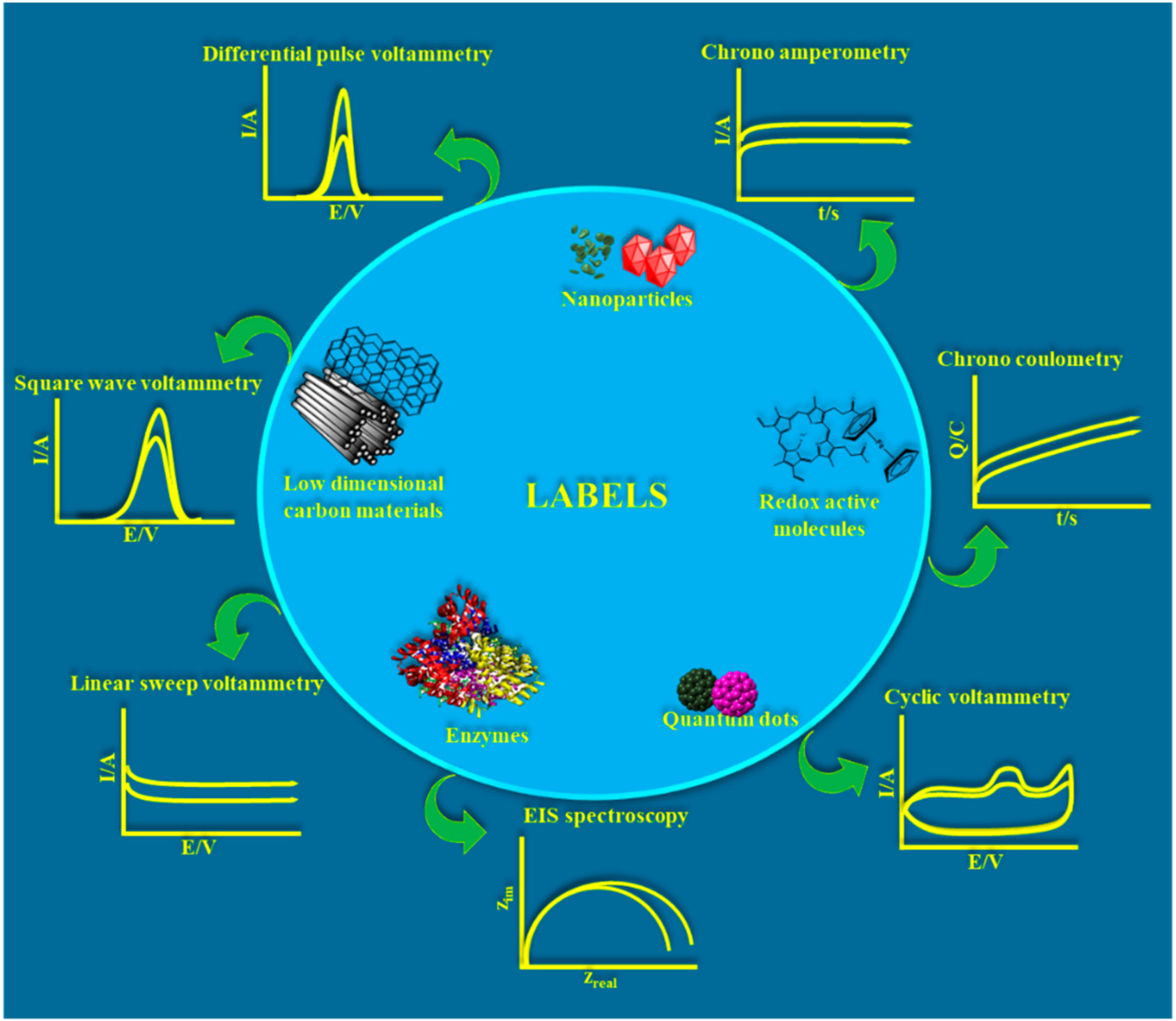



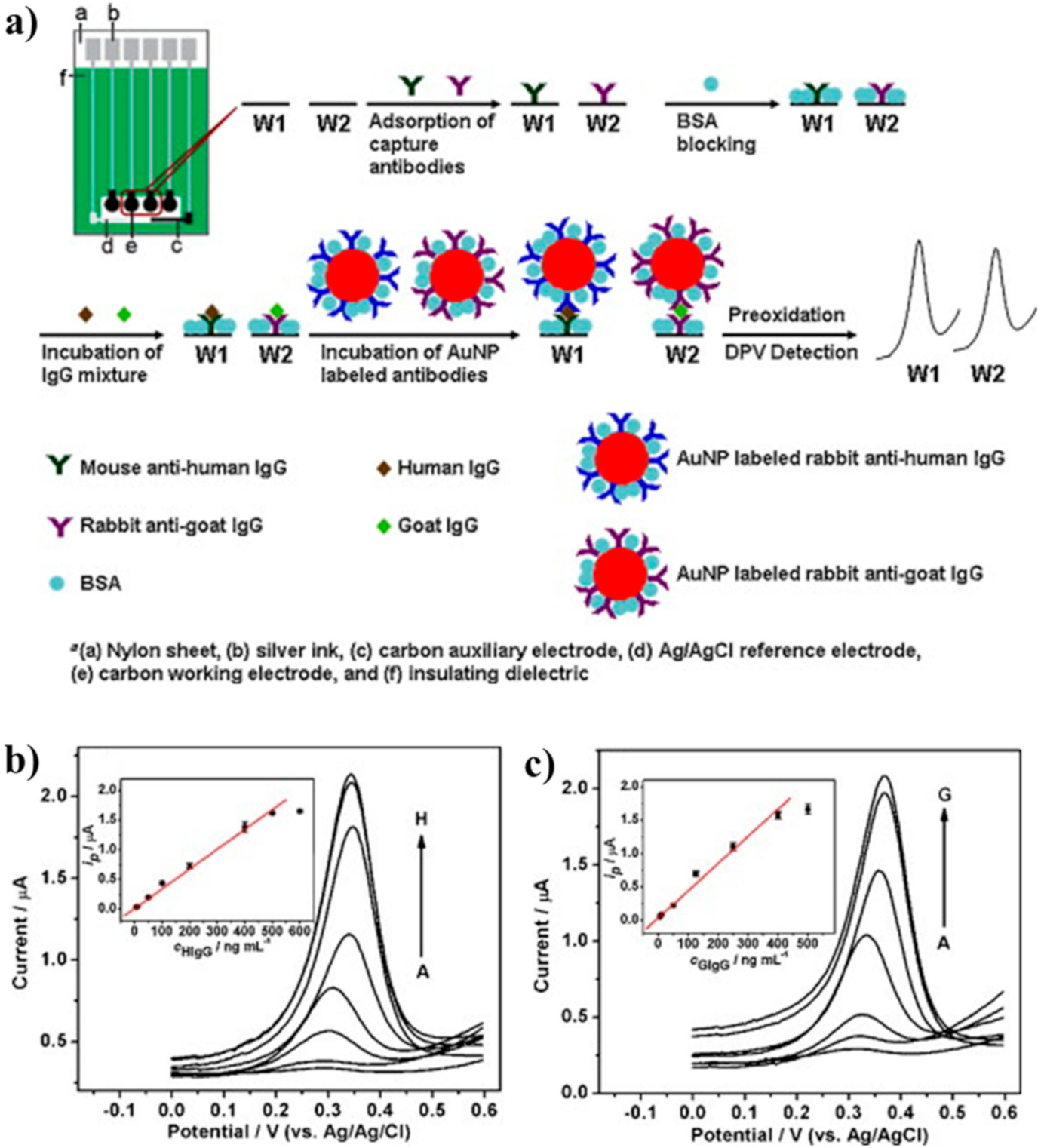
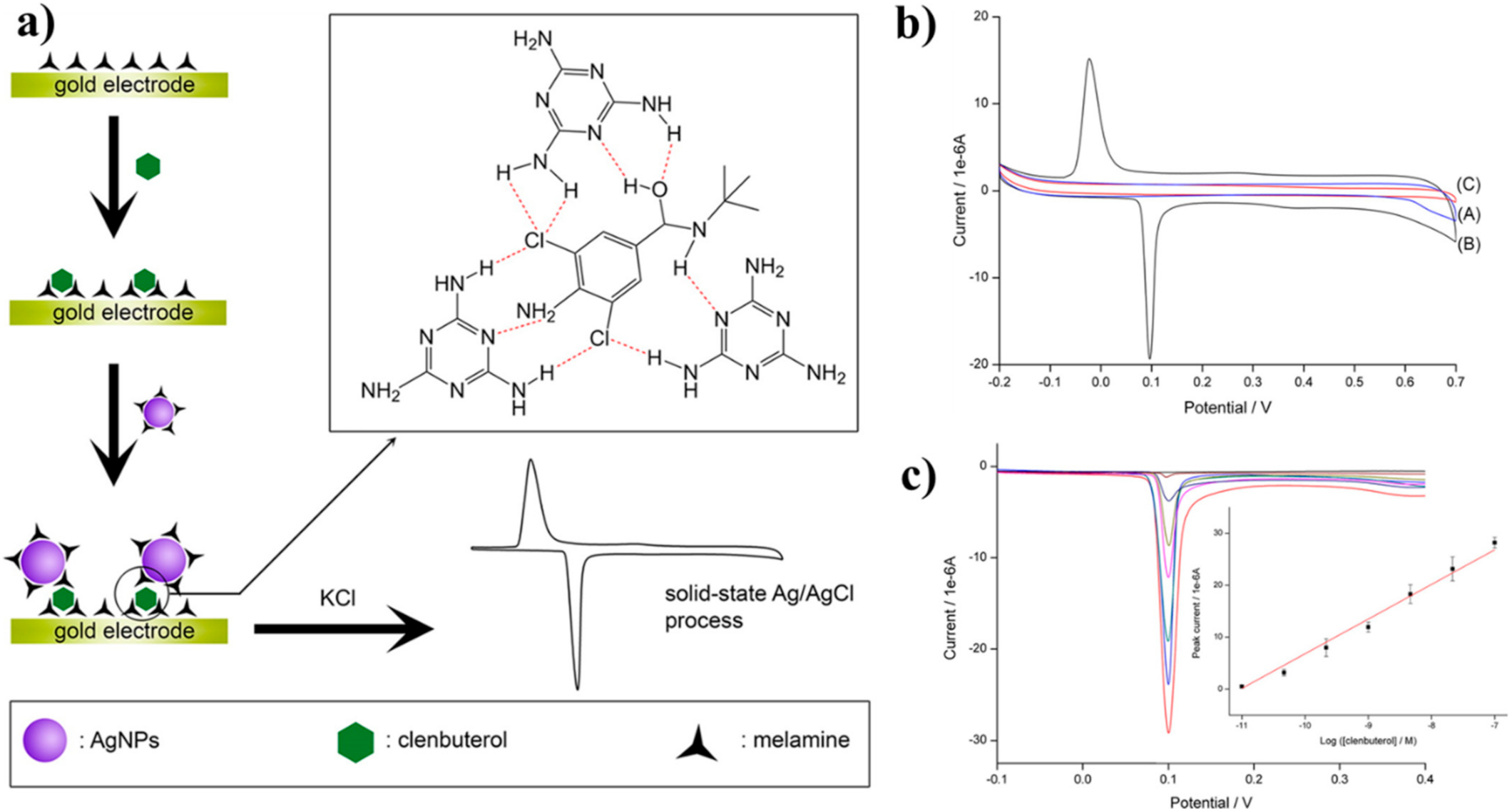
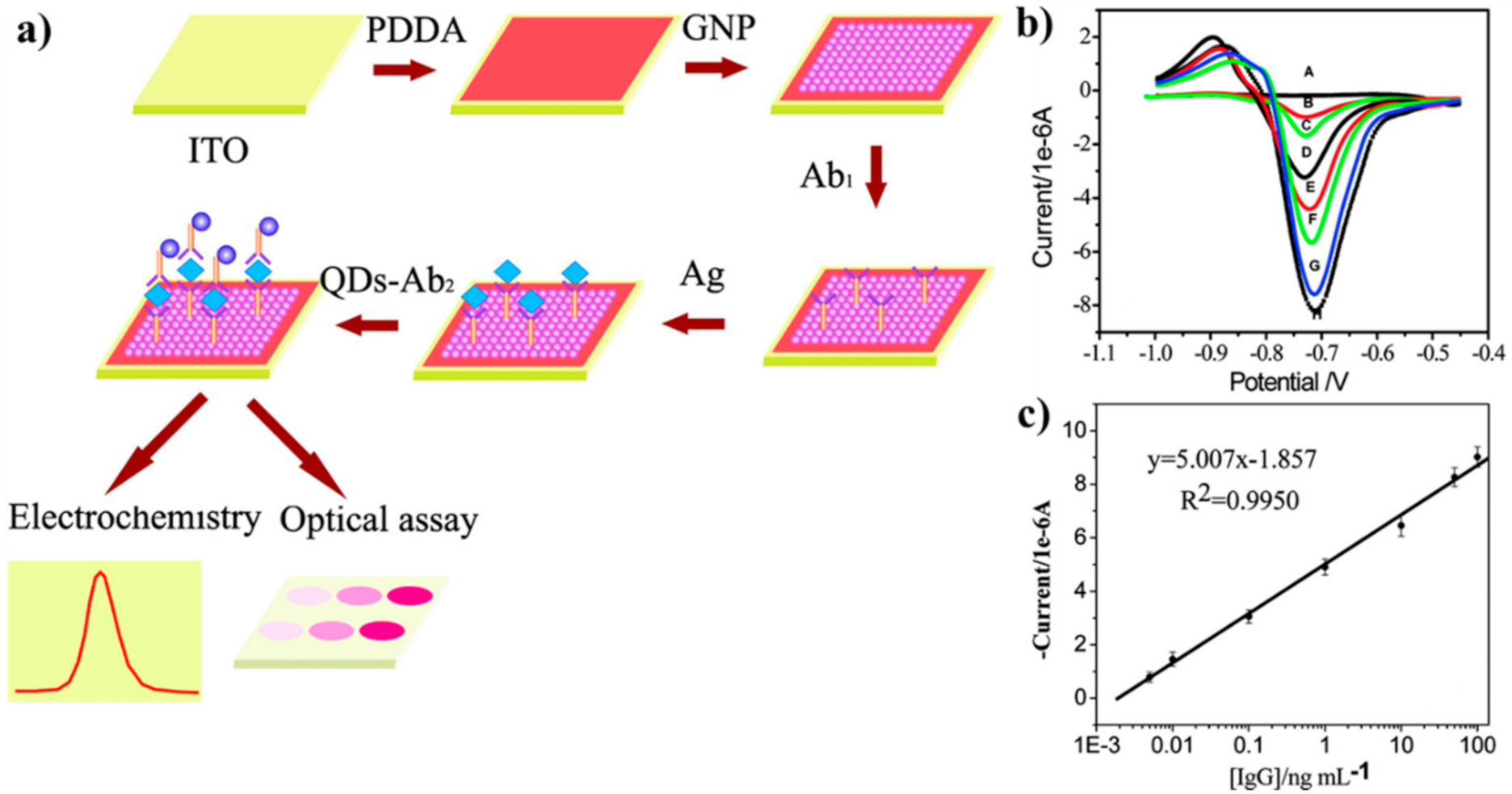
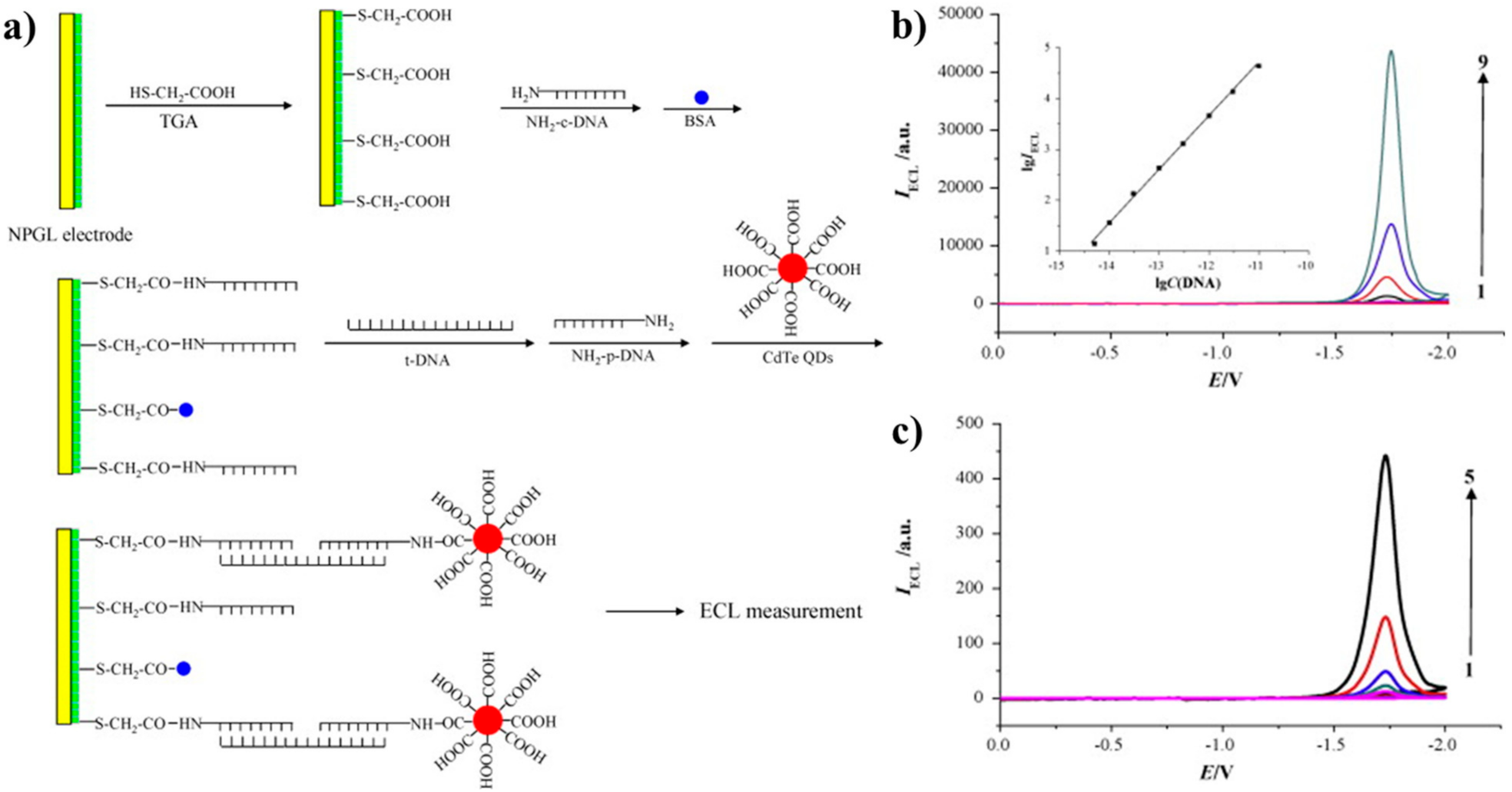
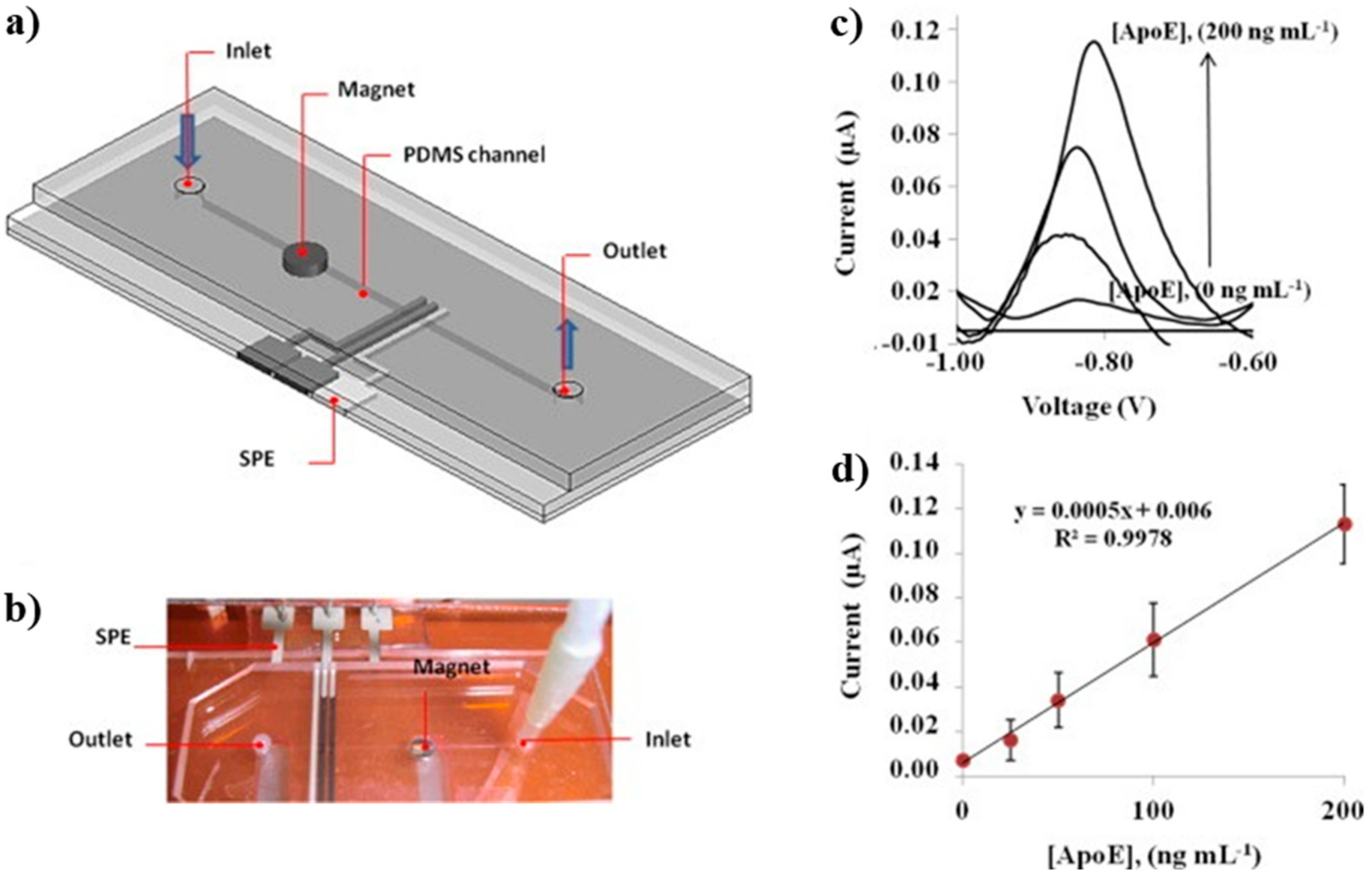

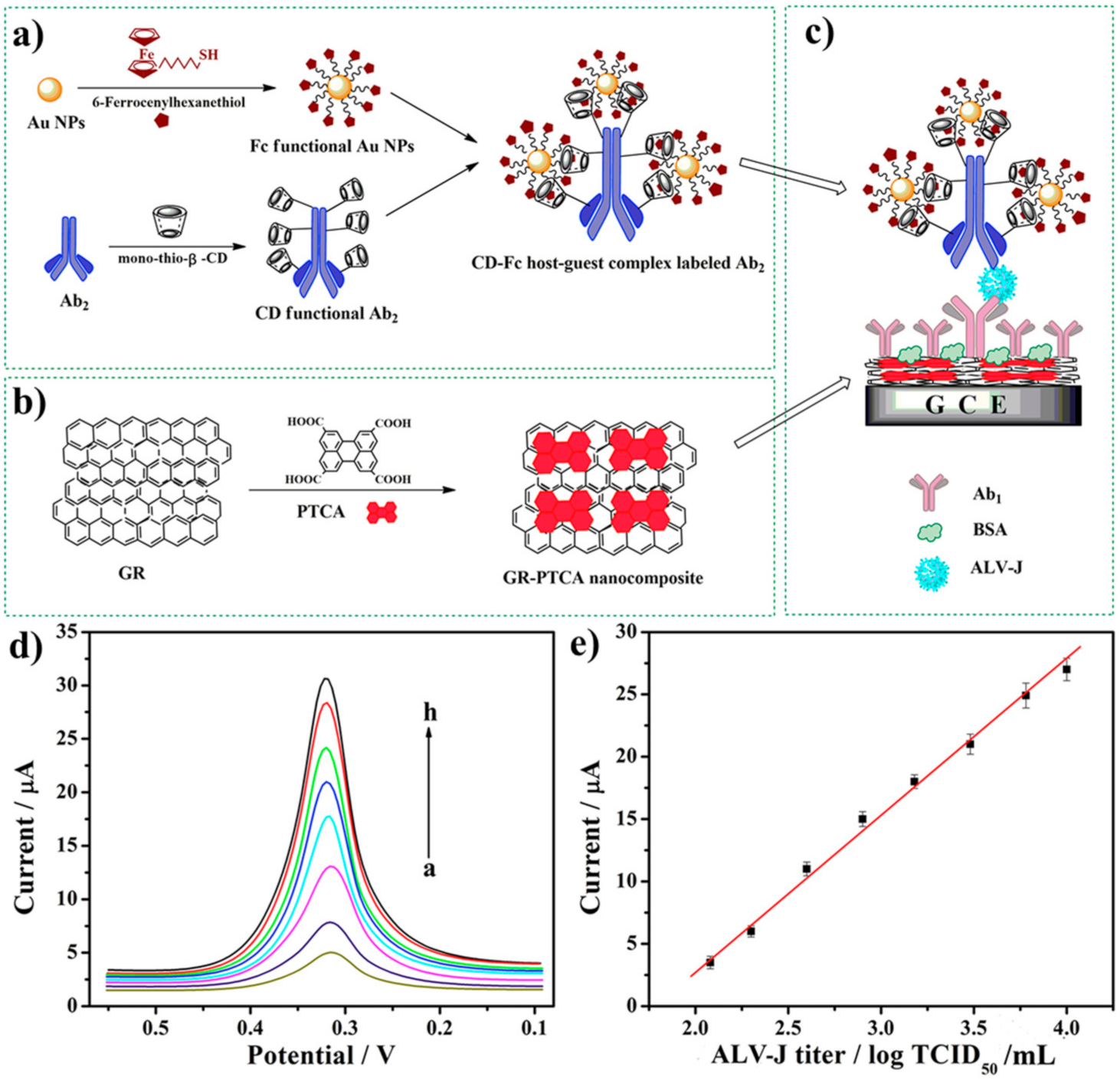

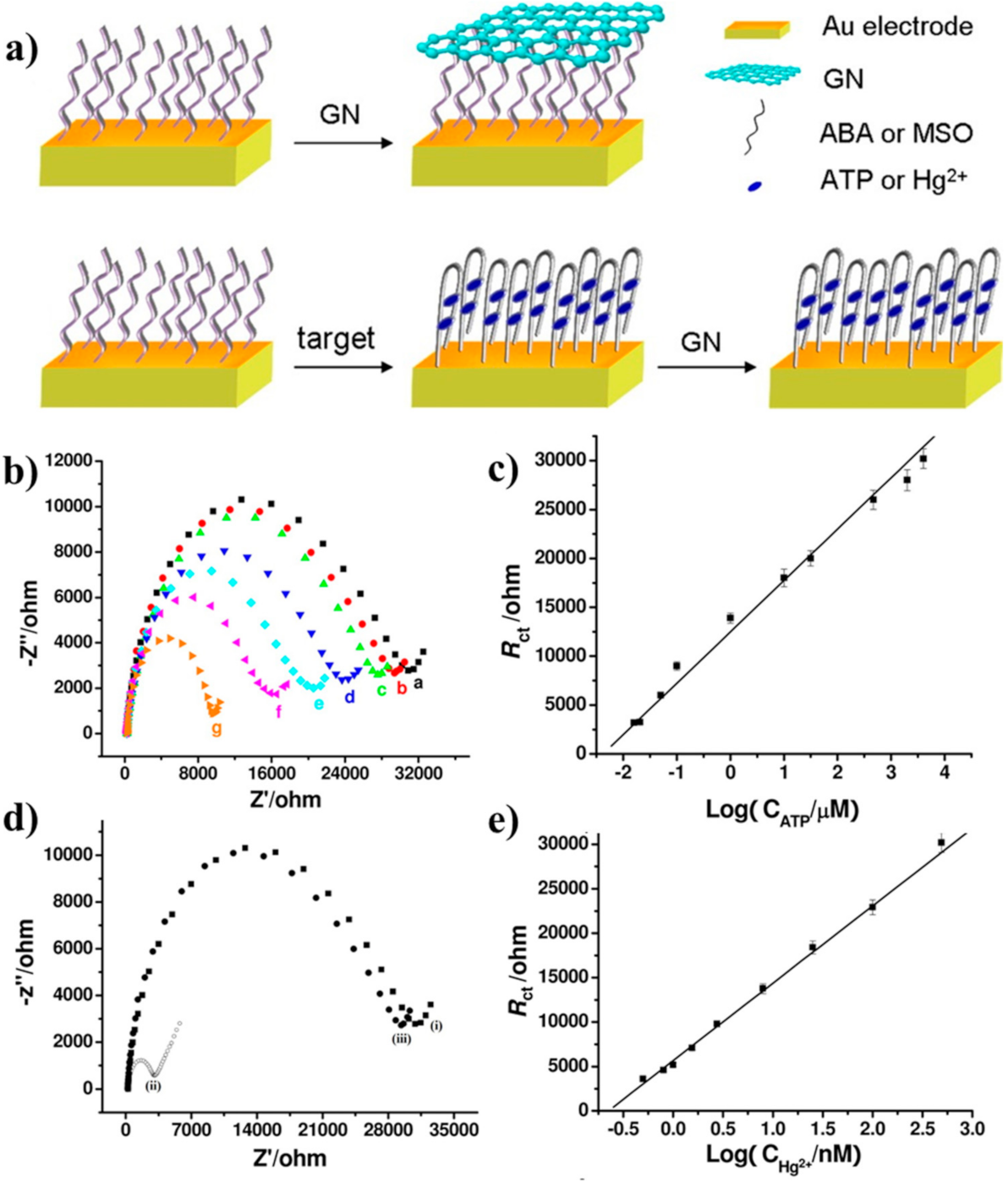
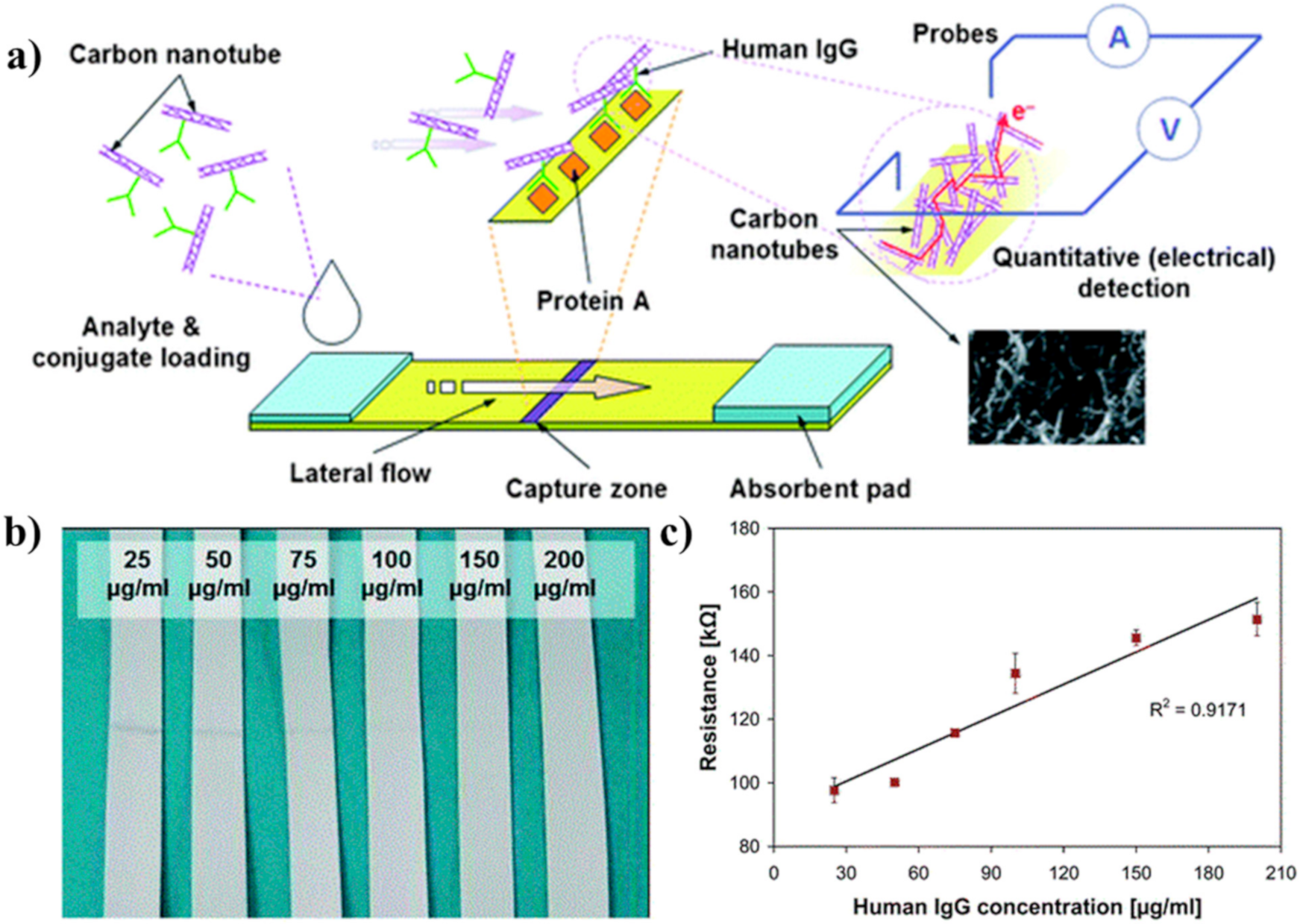
| Label Type | Label | Electrochemical Technique | Target | Linear Range | LOD | Ref. |
|---|---|---|---|---|---|---|
| Enzymes | β-gal | PEC | cTnT | ---- | 1.0 × 10−7 g/L | [21] |
| DT-D | Chronocoulometry | PTH | 2 pg/mL - 1 μg/mL | 2 pg/mL | [22] | |
| GOx | PEC | α-SYN | 50 pg/mL - 100 ng/mL | 34 pg/mL | [69] | |
| ALP | PEC | PSA | ---- | 0.5 ng/mL | [70] | |
| LOx | Amperometry | CA125 | 0.01–100U/mL | 0.002 U/mL | [71] | |
| HRP | Amperometry | PCB | 0.1–50 μg/mL | 0.1 μg/mL | [72] | |
| GPDH | Chronocoulometry | cTnI | ---- | 10 pg/mL | [73] | |
| Nanoparticles | Ag NPs | LSV | Clenbuterol | 0.01–100 nM | 0.01 nM | [24] |
| ZnS NPs | DPV | Codeine | 73 pM - 73 nM | 37 pM | [28] | |
| Au NPs | SWSV | DNA | 0.52–1300 aM | 0.35 aM | [74] | |
| Au-Ag NPs | DPV | E. coli | ---- | 102 CFU/mL | [25] | |
| Pt NPs | LSV | Adenosine | 1–750 nM | 1 nM | [75] | |
| Pd NPs | Amperometry | AFP | 0.1–50,000 pg/mL | 0.033 pg/mL | [76] | |
| Cu NPs | DPV | GSH | 1–1000 nM | 0.27 nM | [77] | |
| Ir NPs | Amperometry | CEA | 0.5–5000 pg/mL | 0.23 pg/mL | [78] | |
| IrO2 NPs | Amperometry | PDBE | ---- | 21.5 ppb | [26] | |
| Fe3O4 NPs | PEC | PSA | 0.05–1000 pg/mL | 18 fg/mL | [27] | |
| MSNs | Amperometry | HIgG | 0.01–10 ng/mL | 5 pg/mL | [79] | |
| MoS2 NPs | Amperometry | RIgG | ---- | 1.94 pg/mL | [80] | |
| Quantum dots | CdS QDs | SWV | PSA | 0.005–10 ng/mL | 3 pg/mL | [81] |
| CdTe QDs | SWV | HIgG | 0.005–100 ng/mL | 5 pg/mL | [46] | |
| CdSe@ZnS QDs | DPV | anti-tTG IgG | 0–40 U/mL | 2.2 U/mL | [82] | |
| Redox-active molecules | Hemin | DPV | DNA | ---- | 2.35 ng/mL | [83] |
| Methylene blue | DPV | SARS DNA | 1–25 μM | 800 nM | [84] | |
| Ru(bpy)32+ | ECL | CEA | 0.2–2000 μg/L | 200 ng/L | [85] | |
| Ferrocene | DPV | miR-141 | 500 aM-50 nM | 138 aM | [86] | |
| Low dimensional carbon materials | SWCNT | DPV | Arsenite | 0.5–10 ppb | 0.5 ppb | [87] |
| GO | DPV | DNA | ---- | 500 pM | [63] | |
| MWCNT | Electrical resistance | HIgG | 25–200 μg/mL | ---- | [68] |
Publisher’s Note: MDPI stays neutral with regard to jurisdictional claims in published maps and institutional affiliations. |
© 2020 by the authors. Licensee MDPI, Basel, Switzerland. This article is an open access article distributed under the terms and conditions of the Creative Commons Attribution (CC BY) license (http://creativecommons.org/licenses/by/4.0/).
Share and Cite
Koyappayil, A.; Lee, M.-H. Ultrasensitive Materials for Electrochemical Biosensor Labels. Sensors 2021, 21, 89. https://doi.org/10.3390/s21010089
Koyappayil A, Lee M-H. Ultrasensitive Materials for Electrochemical Biosensor Labels. Sensors. 2021; 21(1):89. https://doi.org/10.3390/s21010089
Chicago/Turabian StyleKoyappayil, Aneesh, and Min-Ho Lee. 2021. "Ultrasensitive Materials for Electrochemical Biosensor Labels" Sensors 21, no. 1: 89. https://doi.org/10.3390/s21010089
APA StyleKoyappayil, A., & Lee, M.-H. (2021). Ultrasensitive Materials for Electrochemical Biosensor Labels. Sensors, 21(1), 89. https://doi.org/10.3390/s21010089





